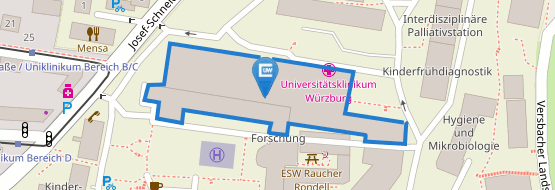A21 - Schulze
Impact of subendothelial matrix proteins on platelet biogenesis
Summary
Platelets are essential mediators of hemostasis, however, they also contribute to the pathogenesis of ischemic diseases like heart attack or stroke. Therefore, the concentration of platelets within blood and their reactivity is tightly regulated. Vessel injury exposes matrix proteins (collagens, fibronectin, laminins) that are otherwise masked underneath the endothelial cell layer that separates blood from the underlying tissue. These matrix proteins are recognized by their corresponding receptors. Activated blood platelets adhere to the injured vessel, aggregate and finally lead to thrombus formation and vessel occlusion in order to prevent excessive bleeding. Within bone marrow, this subendothelial tissue also forms the niche for megakaryocytes (MKs), the immediate precursor cells for platelets. The molecular mechanisms that lead to the migration of megakaryocytic precursors within bone marrow towards this niche and how they mediate the unidirectional release of novel, nascent platelets across this endothelial barrier (designated thrombopoiesis) is overall still poorly understood.
The subproject A21 aims to further develop a system combining fluorescence microscopy (intravital, in vitro as well as in situ immunohistostainings of femur sections) with functional transwell experiments to enable a better molecular understanding of how MKs interact with endothelial cells and the sinusoids during thrombopoiesis. These techniques are to be established taking advantage of reporter mice (CD41wt/eYFP-ki, GPIXmCherry) with intrinsic fluorescent MKs and can later be backcrossed into transgenic mice lacking subchains of matrix proteins (laminin alpha5-chain) or receptors for matrix proteins like the laminin receptor (ITGA6) or collagen receptors (ITGA2, GP6) in order to visualize and analyze the interaction of MKs with the subendothelial proteins. Furthermore, we aim to analyze mouse models harboring a defective platelet function (Itga6fl/fl PF4-Cre, Clec-2fl/fl PF4-Cre) for regenerative thrombopoiesis induced by a systemic platelet depletion.
When these systems are in place, we will modulate the interaction between endothelial cells and MKs by a pharmacological approach, i.e. by using antibodies against vascular endothelial growth factor receptors (VEGFR1 and VEGFR3). In addition, we will change the expression levels of target proteins within MKs by retroviral transduction in order to identify proteins and signaling pathways that regulate the transendothelial passage of MKs during platelet biogenesis. We expect that the characterization of the vascular niche for MKs and thrombopoiesis can identify novel targets for modulating the number and/or the function of peripheral platelets. Finally the results from this project might contribute to open new therapeutic options for patients (for instance after bone marrow transplantation) in order to minimize the period of low platelet counts where they have an increased risk of bleeding.

